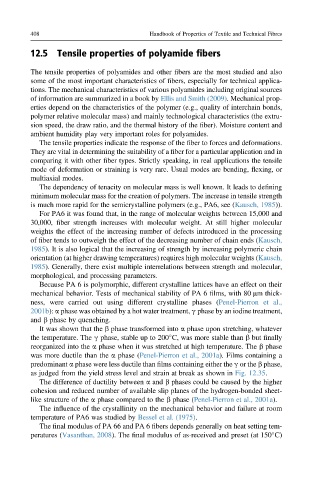Page 435 - Handbook of Properties of Textile and Technical Fibres
P. 435
408 Handbook of Properties of Textile and Technical Fibres
12.5 Tensile properties of polyamide fibers
The tensile properties of polyamides and other fibers are the most studied and also
some of the most important characteristics of fibers, especially for technical applica-
tions. The mechanical characteristics of various polyamides including original sources
of information are summarized in a book by Ellis and Smith (2009). Mechanical prop-
erties depend on the characteristics of the polymer (e.g., quality of interchain bonds,
polymer relative molecular mass) and mainly technological characteristics (the extru-
sion speed, the draw ratio, and the thermal history of the fiber). Moisture content and
ambient humidity play very important roles for polyamides.
The tensile properties indicate the response of the fiber to forces and deformations.
They are vital in determining the suitability of a fiber for a particular application and in
comparing it with other fiber types. Strictly speaking, in real applications the tensile
mode of deformation or straining is very rare. Usual modes are bending, flexing, or
multiaxial modes.
The dependency of tenacity on molecular mass is well known. It leads to defining
minimum molecular mass for the creation of polymers. The increase in tensile strength
is much more rapid for the semicrystalline polymers (e.g., PA6, see (Kausch, 1985)).
For PA6 it was found that, in the range of molecular weights between 15,000 and
30,000, fiber strength increases with molecular weight. At still higher molecular
weights the effect of the increasing number of defects introduced in the processing
of fiber tends to outweigh the effect of the decreasing number of chain ends (Kausch,
1985). It is also logical that the increasing of strength by increasing polymeric chain
orientation (at higher drawing temperatures) requires high molecular weights (Kausch,
1985). Generally, there exist multiple interrelations between strength and molecular,
morphological, and processing parameters.
Because PA 6 is polymorphic, different crystalline lattices have an effect on their
mechanical behavior. Tests of mechanical stability of PA 6 films, with 80 mm thick-
ness, were carried out using different crystalline phases (Penel-Pierron et al.,
2001b): a phase was obtained by a hot water treatment, g phase by an iodine treatment,
and b phase by quenching.
It was shown that the b phase transformed into a phase upon stretching, whatever
the temperature. The g phase, stable up to 200 C, was more stable than b but finally
reorganized into the a phase when it was stretched at high temperature. The b phase
was more ductile than the a phase (Penel-Pierron et al., 2001a). Films containing a
predominant a phase were less ductile than films containing either the g or the b phase,
as judged from the yield stress level and strain at break as shown in Fig. 12.35.
The difference of ductility between a and b phases could be caused by the higher
cohesion and reduced number of available slip planes of the hydrogen-bonded sheet-
like structure of the a phase compared to the b phase (Penel-Pierron et al., 2001a).
The influence of the crystallinity on the mechanical behavior and failure at room
temperature of PA6 was studied by Bessel et al. (1975).
The final modulus of PA 66 and PA 6 fibers depends generally on heat setting tem-
peratures (Vasanthan, 2008). The final modulus of as-received and preset (at 150 C)

